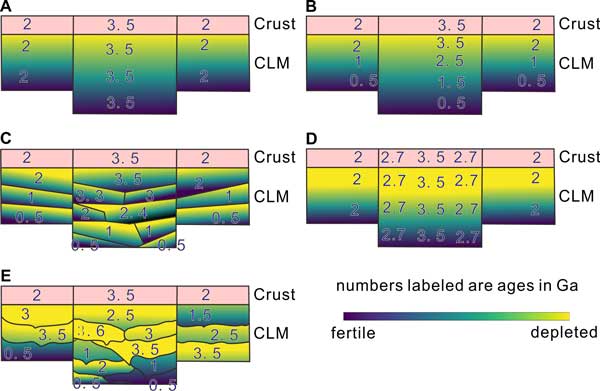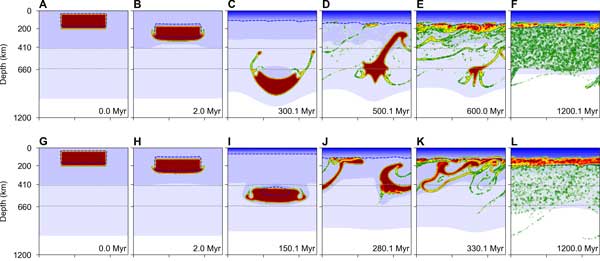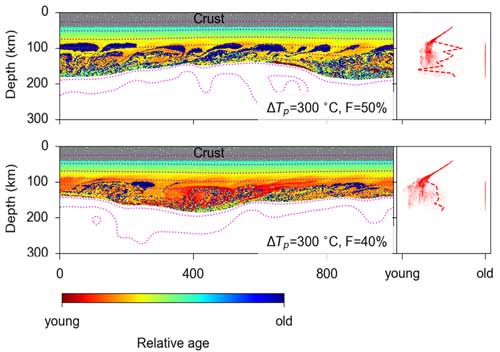|
Zhensheng Wang1, *, Fabio A. Capitanio1,2, Zaicong Wang1, Timothy M. Kusky1,3, *
1State Key Lab of Geological Processes and Mineral Resources, Center for Global Tectonics, School of Earth Sciences, China University of Geosciences, Wuhan, China; jason.wang.cug@qq.com ; fabio.capitanio@monash.edu ; wzc231@163.com ; tkusky@gmail.com
2School of Earth, Atmosphere and Environment, Monash University, Clayton, 3800 VIC, Australia
3Badong National Observatory and Research Station for Geohazards, China University of Geosciences, Wuhan, China
This webpage is a summary of: Zhensheng Wang, Fabio Capitanio, Zaicong Wang, and Timothy Kusky. Accretion of the cratonic mantle lithosphere via massive regional relamination. Proceedings of the National Academy of Sciences, 2022, 119 (39) e2201226119. https://doi.org/10.1073/pnas.2201226119
The origin of the continental crust, and its relationship to the deep mantle part of the continental lithosphere known as cratonic mantle or lithospheric roots, is complex and controversial. Lithospheric roots are particularly thick under some Archean cratons, and some show complex age structures with depth. Some have older material beneath younger, some younger beneath older, and some have similar ages throughout (Heaman & Pearson, 2010; Pearson, 1999; Pearson et al., 2021; Wittig et al., 2010). To date, no single model has been able to explain these observations.

Figure 1. Predicted age and chemical composition (depletion) architecture of lithospheric mantle formed by different mechanisms (modified after Pearson, 1999). A, Rapid plume or rapid subduction. B, Underplating: cooling or magmatic. C, Subduction accretion. D, Lateral “block” accretion. E, Repeated MRR events proposed in this study. Most continental lithospheric mantle has a structure that most closely resembles E, which is produced by the mechanism proposed herein.
In our new work, geodynamic numerical modeling and geological observations are used to develop a model that explains these enigmatic relationships. We propose a new mechanism for recycling old continental material from one continental root, having it sink deep into the mantle and then return in pieces in periodic pulses to relaminate to the base of other plates. These could be oceanic or continental, the process could extend over periods up to hundreds of millions of years, and it could thus explain the enigmatic age structure of continental lithosphere. We name this new mechanism for forming the deep roots of continents “massive regional relamination” (MRR). The MRR model works as follows.
The subcontinental lithospheric mantle can form by the stacking of subducted oceanic plates, melt extraction from the mantle, mantle plumes, or other mechanisms (Capitanio et al., 2020; Kusky, 1993; Lee et al., 2011; Liu et al., 2021; Pearson, 1999; Pearson et al., 2021; Perchuk et al., 2020; Wang et al., 2022). It has highly variable characteristics as shown by samples from deep volcanoes and kimberlites and its age structure is variable. In most cases the lithospheric mantle is chemically buoyant but with time it thickens and cools eventually becoming so dense it is negatively buoyant and delaminates and sinks into the deep mantle. We model the subsequent fate of these delaminated pieces.

Figure 2. Sample of results from the numerical model showing time steps of how the original roots of continents (in red on left) sink into the mantle, becoming heated with time (increasing to the right), and rise back up in pulses to relaminate the base of lithosphere in other locations. The two model runs (top and bottom rows) start with mantle roots with slightly different compositions. Since tectonic plates move, this mechanism can transfer material from one continent to another, either continental or oceanic. This process can explain the complex structure of the mantle beneath continents, and also the presence of old material in young oceanic regions.
Depending on the exact composition of the mantle lithosphere, there are many possibilities. In most cases, the root sinks en masse to the mantle transition zone, gradually heats up, and then rises in blobs periodically every 10 to 100 million years. These blobs rise and relaminate the base of whatever lithospheric plate lies above at that time. Since the surface plates move constantly, old parts of lithospheric plate may be transferred between plates. This can explain the complicated age distribution of many continental lithospheres and the difficulty in correlating crustal geology with deep lithospheric mantle structure (Liu et al., 2015; Pearson et al., 2021; Xu et al., 2020). The model also explains recent findings of ancient material along some mid-ocean ridges (Foulger et al., 2020; Liu et al., 2022; Liu et al., 2008) and in other parts of the ocean basins (Bizimis et al., 2007; Coltorti et al., 2010; Ishikawa et al., 2011; Liu et al., 2015; Wang et al., 2017; Zhou & Dick, 2013), and the sporadic distribution of diamonds in some parts of Archean cratons but not in others.

Figure 3. Sample of results of numerical model, illustrating the complexity of continental lithosphere formed by massive regional relamination events. The crust, in gray in the top panel, is underlain by a complex mixture of material of different ages, and compositions, derived from pieces of different continental roots that sank into the mantle, became buoyant, and rose to relaminate and thickening continental roots through time.
References
- Bizimis, M., Griselin, M., Lassiter, J. C., Salters, V. J. M., & Sen, G. (2007). Ancient recycled mantle lithosphere in the Hawaiian plume: Osmium–Hafnium isotopic evidence from peridotite mantle xenoliths. Earth and Planetary Science Letters, 257, 259-273.
- Capitanio, F. A., Nebel, O., & Cawood, P. A. (2020). Thermochemical lithosphere differentiation and the origin of cratonic mantle. Nature, 588, 89-94.
- Coltorti, M., Bonadiman, C., O'Reilly, S. Y., Griffin, W. L., & Pearson, N. J. (2010). Buoyant ancient continental mantle embedded in oceanic lithosphere (Sal Island, Cape Verde Archipelago). Lithos, 120, 223-233.
- Foulger, G. R., Doré, T., Emeleus, C. H., Franke, D., Geoffroy, L., Gernigon, L., Hey, R., Holdsworth, R. E., Hole, M., Höskuldsson, Á., Julian, B., Kusznir, N., Martinez, F., McCaffrey, K. J. W., Natland, J. H., Peace, A. L., Petersen, K., Schiffer, C., Stephenson, R., & Stoker, M. (2020). The Iceland Microcontinent and a continental Greenland-Iceland-Faroe Ridge. Earth-Science Reviews, 206, 102926.
- Heaman, L. M., & Pearson, D. G. (2010). Nature and evolution of the Slave Province subcontinental lithospheric mantleThis article is one of a series of papers published in this Special Issue on the theme Lithoprobe — parameters, processes, and the evolution of a continent. Canadian Journal of Earth Sciences, 47, 369-388.
- Ishikawa, A., Pearson, D. G., & Dale, C. W. (2011). Ancient Os isotope signatures from the Ontong Java Plateau lithosphere: Tracing lithospheric accretion history. Earth and Planetary Science Letters, 301, 159-170.
- Kusky, T. M. (1993). Collapse of Archean orogens and the generation of late-to postkinematic granitoids. Geology, 21, 925-928.
- Lee, C. A., Luffi, P., & Chin, E. J. (2011). Building and destroying continental mantle. Annual Review of Earth and Planetary Sciences, 39, 59-90.
- Liu, C., Dick, H. J. B., Mitchell, R. N., Wei, W., Zhang, Z., Hofmann, A. W., Yang, J., & Li, Y. (2022). Archean cratonic mantle recycled at a mid-ocean ridge. Science Advances, 8, n6749.
- Liu, C. Z., Snow, J. E., Hellebrand, E., Brügmann, G., Handt, A. V. D., Büchl, A., & Hofmann, A. W. (2008). Ancient, highly heterogeneous mantle beneath Gakkel ridge, Arctic Ocean. Nature, 452, 311-316.
- Liu, J., Scott, J. M., Martin, C. E., & Pearson, D. G. (2015). The longevity of Archean mantle residues in the convecting upper mantle and their role in young continent formation. Earth and Planetary Science Letters, 424, 109-118.
- Liu, J., Pearson, D. G., Wang, L. H., Mather, K. A., Kjarsgaard, B. A., Schaeffer, A. J., Irvine, G. J., Kopylova, M. G., & Armstrong, J. P. (2021). Plume-driven recratonization of deep continental lithospheric mantle. Nature, 592, 732-736.
- Pearson, D. G. (1999). The age of continental roots. Lithos, 24, 171-194.
- Pearson, D. G., Scott, J. M., Liu, J., Schaeffer, A., Wang, L. H., van Hunen, J., Szilas, K., Chacko, T., & Kelemen, P. B. (2021). Deep continental roots and cratons. Nature, 596, 199-210.
- Perchuk, A. L., Gerya, T. V., Zakharov, V. S., & Griffin, W. L. (2020). Building cratonic keels in Precambrian plate tectonics. Nature, 586, 395-401.
- Wang, Z., Kusky, T., & Capitanio, F. (2017). Ancient continental lithosphere dislocated beneath ocean basins along the mid-lithosphere discontinuity: A hypothesis. Geophysical Research Letters, 44, 9253-9260.
- Wang, Z., Kusky, T., & Wang, L. (2022). Long-lasting viscous drainage of eclogites from the cratonic lithospheric mantle after Archean subduction stacking. Geology, 50, 583-587.
- Wittig, N., Webb, M., Pearson, D. G., Dale, C. W., Ottley, C. J., Hutchison, M., Jensen, S. M., & Luguet, A. (2010). Formation of the North Atlantic Craton: Timing and mechanisms constrained from Re–Os isotope and PGE data of peridotite xenoliths from SW Greenland. Chemical Geology, 276, 166-187.
- Xu, Y., Liu, J., Xiong, Q., Su, B., Scott, J. M., Xu, B., Zhu, D., & Pearson, D. G. (2020). The complex life cycle of oceanic lithosphere: A study of Yarlung-Zangbo ophiolitic peridotites, Tibet. Geochimica Et Cosmochimica Acta, 277, 175-191.
- Zhou, H., & Dick, H. J. B. (2013). Thin crust as evidence for depleted mantle supporting the Marion Rise. Nature, 494, 195-200.
last updated 27th November, 2022 |
